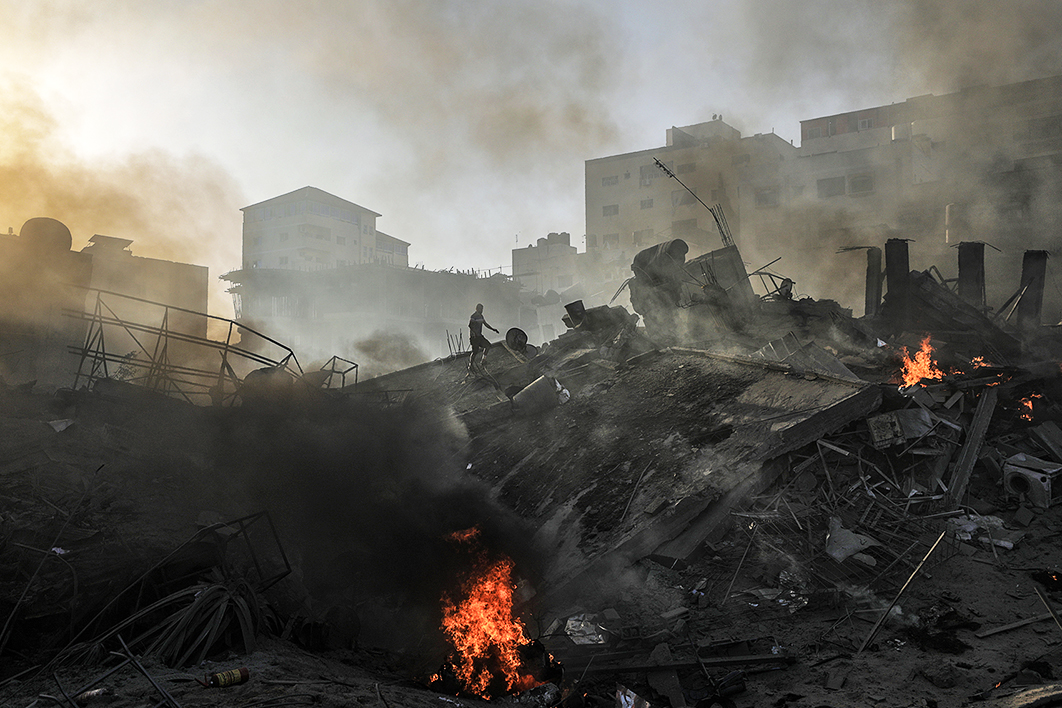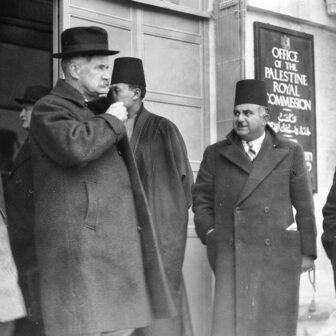Israeli bases its defence strategy on deterrence. To avoid fighting wars it must show how well it can fight if it needs to. Potential adversaries must be persuaded not to take aggressive action by warning them of the consequences if they do.
Deterrence’s conceptual framework developed around nuclear weapons. This is deterrence of a special kind, because of the absolute nature of the weapons and how hard it is to use them to win a war given the threat of retaliation in kind. We can see the caution this induces at work in the Russo-Ukraine War. NATO has not engaged directly on Ukraine’s behalf; Russia has not attacked NATO countries.
Israel also practises nuclear deterrence. It has its own arsenal, which it prefers not to talk about. It is geared to deterring Arab governments, and now Iran, from starting wars intended to destroy the Jewish state. As with all nuclear deterrence, it does not require demonstrations of what the weapons can do or a readiness to use them. All that is required is for potentially hostile governments to be aware of what could happen if an inter-state war escalates too far.
For lesser contingencies, including the threats posed by Hamas operating out of Gaza and Hezbollah out of Lebanon, deterrence looks quite different. It is not based on absolute weapons and nor does it offer constant relief from danger. There is no guarantee of success and so when it fails, if only slightly, it must be restored. It is more like a fence that easily breaks but can then be mended than a solid brick wall. Unlike nuclear deterrence, there can be no sole reliance on threats but instead a readiness to respond forcefully to any challenge to bring home to adversaries the folly of attacking Israel.
It is this deterrence that failed on 7 October 2023 and may never be restored. An enemy so irredeemably hostile that it will always be looking for ways to attack, whatever the severity of the likely response, appears beyond deterrence. Instead of deterring Hamas, Israel now wants to eliminate it as a political and military force, but any relief achieved by this approach might also be only temporary.
WHY DETERRENCE?
Before it became so dependent on deterrence, Israel sought to control threats directly by maintaining a substantial presence in Gaza and Lebanon. The costs of maintaining that presence proved too high.
In the case of Lebanon, Israel became fully engaged in the 1970s after the Palestine Liberation Organisation, having been kicked out of Jordan, took up residence there in 1970. Because Lebanon was being used to mount raids, Israel occasionally entered its territory to push the guerilla bases further away from its northern border. Then, in 1982, it entered in force, moving north until it laid siege to Beirut. The aim was to push the PLO out (with some success) and also to install a government willing to make peace with Israel (in which it failed completely). Hezbollah in its current form is a lasting consequence of those events.
The Israeli Defence Forces, or IDF, eventually withdrew to a strip of southern Lebanon, which they policed with a Christian militia. In 2000, after Israeli prime minister Ehud Barak decided the presence there was doing more harm than good, they withdrew unilaterally. Hezbollah concluded that this was a great victory and a result of its constant harassment.
Five years later Israel left Gaza, again unilaterally. Ariel Sharon, a hardliner who had made his career by being tough on Arabs and was most responsible for the debacle in Lebanon, decided as prime minister that the effort to hold on to Gaza was futile because Israel’s position could only be sustained at an inordinate cost. He ordered withdrawal. In the face of protests from their residents, the IDF closed down the settlements. (Sharon suffered a stroke and went into a coma before he could reveal what he had in mind for the West Bank.)
The withdrawal was not negotiated with the Palestinians. No plans were made for what could follow. There were hopes that Gaza might turn a corner, replacing its seething resentment at occupation with economic development, but such hopes didn’t last long. Within two years Hamas was in control, first as a result of an election victory and then having won a short civil war with the Palestinian Authority.
With only rejectionist parties active in the territory, and no interest in coexistence with Israel, Hamas turned Gaza into its base, using all available resources, including those obtained from Iran, to manufacture rockets and build tunnels for smuggling supplies and getting fighters into Israel.
DETERRENCE BY DENIAL OR PUNISHMENT
With two implacably hostile neighbours in positions to attack Israel at any time, and having abandoned the idea that they could be occupied, deterrence became the centrepiece of Israeli strategy.
Deterrence is usually described as taking one of two forms. The first is deterrence by denial, which basically means that, whatever the target’s aggressive intent, it will be unable to act upon it because it will be thwarted if it tries. The other is deterrence by punishment. In this case the target can act on hostile intent, and even do some real harm, but the punishment will be severe, and whatever the gains the costs suffered will be far higher. When an adversary is not deterred, and decides to attack, the costs must be sufficient to ensure that it does not try again. In this way deterrence can be restored.
Israel follows both forms of deterrence. For denial it constructs large fences to prevent incursions into its territory. But the fences couldn’t stop rockets fired by Hamas or Hezbollah. So Israel also developed an elaborate and advanced air defence system — the Iron Dome – to prevent rocket attacks doing too much damage. The population can also use air raid shelters to protect them from rockets that get through.
The success rate of this system is impressive but not complete, and the attacks are cheaper to mount than to stop. So Israel normally seeks to add to the price for the perpetrators with air raids on the places from where they have been launched. There is always an element of punishment.
The punishment comes in three forms. First, it attempts to assassinate those responsible, whether political figures or military. Israel’s many “targeted killings” may have disrupted the enemy’s command structures and operations in the short term, but their long-term effects are at most marginal. Other commanders step up to take the place of those killed, and there is no guarantee they will be less capable or effective.
Second, the IDF targets the military assets that make the attacks possible. Again, this can make a difference in the short term but in the long term more rockets can be built, more tunnels dug and more fighters recruited.
Third, because these assets are to be found in the middle of urban areas, often deliberately near schools and hospitals, civilians will suffer. Israel denies that it engages in collective punishment and the deliberate targeting of civilians. In the name of self-defence and military necessity, it is not a war crime to attack areas where civilians may be present if armed units are also there. Hamas can be blamed for fighting out of such populated areas and Israel urges civilians to move away from areas where fighting is likely to be intense.
But intense strikes against military targets, especially involving tunnels believed to be below occupied buildings or individuals hiding in residential areas, are going to involve many civilian casualties and wider suffering. For onlookers the distinction between collateral and deliberate damage is often hard to discern.
Another feature of deterrence is that it appears as all stick and no carrot. There is no reason in principle why negative threats can’t be combined with positive inducements, but it is not a requirement of the strategy. And if the threats are working, there is less reason to find incentives to encourage a potential adversary to coexist peacefully.
DOES IT WORK? (I) HEZBOLLAH
In July 2006 Hezbollah conducted a raid into Israel, combining rockets fired into border towns and an attack on an Israeli patrol that left three soldiers dead and two abducted to Lebanon. A failed rescue attempt led to three more deaths. Israel refused Hezbollah’s demand to swap Lebanese prisoners in Israeli jails for the abducted soldiers. It responded instead with air and artillery strikes, against not only Hezbollah military targets but also Beirut airport and other civilian targets. It launched a land attack against well-prepared Hezbollah positions in southern Lebanon that turned out to be costly and difficult.
Eventually the United Nations arranged a ceasefire. Much later the remains of the two soldiers were returned as part of a prisoner exchange. The operation was widely considered a failure in Israel, having exposed the country’s weaknesses to rocket attacks and a determined militia. Yet Hezbollah’s leader, Hassan Nasrallah, acknowledged that the Israelis had killed up to twelve of his commanders and went on to make an interesting comment about the initial operation.
On the question of whether Hezbollah’s operation would have proceeded if it was felt there was “even a 1 per cent chance” it would lead to a war like the one that eventuated, he responded, “I would say no, absolutely not, for humanitarian, moral, social, security, military, and political reasons.” Israel had been waiting for an excuse for a planned attack, he added — yet this admission, and the fact that there have been clashes since but nothing quite comparable, has been taken as evidence that deterrence can perhaps work.
But while Hezbollah is undoubtedly antagonistic towards Israel, it is less so than Hamas. One reason for this is that Hezbollah is now part of the Lebanese political system. While it is the most substantial force in that country, it still has to be responsive to factions and persuasions that are less interested in its feud with Israel, and to present itself as serving Lebanese interests. With the country in an economic mess, aggravated by the massive blast at the Beirut port in 2020, and still being run by a caretaker government, it is in no position to cope well with a war with Israel. Nor is Israel angling for a war with Lebanon.
This is not straightforward Israeli deterrence. Hezbollah’s agenda is as much set by Iranian considerations as Lebanese. It sent its fighters into Syria during the civil war there, for example, where they worked (not particularly effectively) with Iranian and Russian forces to prop up the Assad regime. (It is perhaps worth noting that the Sunni Hamas did not support Assad.) It depends on Iran for its military assets, including its large number of missiles, which are much more capable than those of Hamas. It has no particular incentive to go to war with Israel other than as part of a larger Iranian project.
DOES IT WORK? (II) GAZA
The Gaza experience has been different. Ever since Hamas took over the territory, the periods of calm on the border have been few. Clashes have varied in intensity and frequency, with big ones every few years. Each case involves rocket fire by Hamas (and its junior partner, Islamic Jihad) and air and artillery strikes by the Israelis; the casualties are starkly asymmetric, with those on the Palestinian side far greater than those on the Israeli, especially for civilians.
The suffering of Palestinians in these flare-ups leads international organisations, governments and campaigning groups to denounce Israel for acting disproportionately. Other than in 2021, when unrest spread to Arab communities in Israel, supporting protests have been held in the West Bank and elsewhere, but not much more. After weeks of fighting, a ceasefire of some sort has been struck and nothing much has changed once the fighting subsided.
The regularity of the clashes suggests that deterrence has worked poorly in Gaza. From the Israeli perspective the priority has mainly been to show that it is not rattled by provocations and will respond forcefully each time. These responses were described by some Israelis as “mowing the lawn,” a phrase capturing the idea of an indefinite conflict containable by occasional forceful action.
Part of the shock of 7 October was that the Israeli government had convinced itself that its approach was working, to the extent that it was starting to ease the restrictions on Gaza. Islamic Jihad was a problem, but Hamas didn’t seem too interested in any more violence. What happened then, in Israeli eyes, was a failure not only of intelligence but also of deterrence, and the extent of the failure meant restoring deterrence no longer seemed an option.
The response followed the same pattern as before, except with more intensity. Many individuals connected with Hamas and in particular the attacks of 7 October have been targeted and killed. Military infrastructure has been hit mercilessly, and the consequences of Hamas’s actions have been brought home to the suffering population far more ferociously than in past episodes and with far more civilian casualties and general distress. Despite Hamas’s original provocation, this has led to international anger and demands for a ceasefire.
We can question whether deterrence was ever operating effectively, but it certainly isn’t now. Israel has no interest in persuading Hamas not to attack again. It wants to make sure that it never has the capacity to do so.
But it does need to deter Hezbollah, and in practice Iran. The latter’s network, including the Houthis in Yemen, has been busy. So far, much of that has been largely posturing, with the aim of demonstrating what might happen if the war continues at its current pace. In this respect it might be argued that the deterrence offered by Iran/Hezbollah has failed because Israel has pressed on regardless with its ground war, though they might claim that they are tying down Israeli forces that might otherwise be used against Hamas.
If Hezbollah did want to get involved, it would have had more effect if it had done so early on. Israel is now geared up for a two-front war, including evacuating people from the border with Lebanon and restocking the Iron Dome. This doesn’t mean Hezbollah won’t get involved, especially if the accusations of letting Hamas down start to worry its leadership. But the key decisions will be taken in Teheran, which will have to consider whether this is the issue with which to take on the United States. A tweet from Iran’s president, Ebrahim Raisi — “Zionist regime’s crimes have crossed the red lines, which may force everyone to take action” — suggests that no decision has yet been made.
The pressure will also grow on other Arab countries to do more than issue statements, especially those like Saudi Arabia that have already “normalised” relations with Israel or were preparing to. It is hard to assess how they will act, but if they look ahead they should see a significant role for themselves in shaping the new order that might yet emerge.
NEXT STEPS
Israel’s land invasion of Gaza was undertaken despite US misgivings and Saudi objections — one a country on which Israel relies, the other that it has been courting. The foreign ministry has insulted the numerous countries supporting the ceasefire resolution in the General Assembly, and refused to talk to UN secretary-general António Guterres because he saw equivalence between the unprovoked attacks on Israel’s people and the ruthless response undertaken in the name of self-defence.
Israel can note that it is hardly the only state in the region that puts its security needs above humanitarian considerations. The past decade has seen extraordinary loss of life in the battles against Islamic State and in the civil wars in Syria and Yemen (the last two with hundreds of thousands of civilian deaths). But the pressure on it to stop will only grow. Israel is used to treading a lonely path, and it may find its position gets lonelier. As with its previous wars, it will be resisting pressure for a ceasefire until its objectives have been achieved.
Can its objectives be achieved? That is not yet a given. Information on what is going on in the battles in northern Gaza and towards Gaza City are sketchy, so it is unwise to speculate. It is also unclear how much humanitarian assistance will be able to get into Gaza in these conditions, and whether countries like Qatar are still potential mediators, including in efforts to get hostages released. In all of this, the biggest uncertainty away from the battlefield and the potential widening of the war is the future governance of Gaza.
Israel has been forced to look beyond deterrence. It has concluded that it is dealing with an entity that has never truly been deterred and can’t be deterred in the future. Wilder elements in Israel may fantasise about pushing all the Gazans out of the territory, but that is not a serious option. This is where the other flaw in Israel’s deterrence strategy becomes painfully evident. It has not been accompanied by a more positive political strategy. The only long-term vision Israel offers is a Gaza without Hamas. The chaos and instability that would result if Gaza were turned into an ungovernable space without anyone in charge would serve nobody’s interests. A way will have to be found to fill the space.
Given how Israel has defined its objectives, success for Hamas simply requires surviving in a commanding position in Gaza. Even if it is forced to evacuate its positions, Hamas will not disappear. It represents a strong political tradition in the Arab world, and regardless of what happens to it over the coming weeks it will have the capacity to regenerate and to return to power if there is no alternative government in place.
There is no evidence of great love for Hamas among Gazans, and at some point they will reflect on the missed opportunities to develop the territory and the wisdom of its constantly provoking Israel into attacks that it is unable to mitigate. Nor is there much respect for the Palestinian Authority, which is generally considered to be inept, corrupt and unable to stand up at all to the Israelis. Though constitutionally the PA’s return to Gaza would seem the best option, this would be greeted suspiciously in the best of circumstances and even more so if it arrived behind Israeli tanks. Any government installed by Israel would lack legitimacy and would be a natural target for assassins.
If Israel can’t find a government for Gaza, someone else will have to. Here the main initiative will have to come from the Arab world, probably in concert with the United States. This seems to be what many analysts anticipate happening after this war. It is possible, for example, to imagine at some point a multilateral conference including the main Arab and Western players, with Israel on the sidelines, given the job of coming up with a viable government for Gaza and managing the influx of aid necessary if the territory is to recover from the traumas of the past weeks and look to possibilities for future development. It would also need to consider both Gaza’s internal security and how to stop it causing trouble to its neighbours (Egypt as well as Israel) in the future.
In principle, this process could be confined to Gaza, but Arab governments are unlikely to cooperate unless the future of the West Bank is also tackled. The trade that Israel faces in return for insisting that Hamas plays no part in the territory’s government is that the “two-state solution” is put back on the agenda. Most Western governments have already been quite explicit on this matter.
Netanyahu has been around long enough to know that dismissing the two-state solution out of hand isn’t realistic, even though he has built his career on subverting the idea. That’s why he was content to leave the rejectionist Hamas in charge in Gaza as he made life difficult for the Palestinian Authority in the West Bank. The encroachment of settlements on the West Bank has made the prospect of a viable Palestinian state there seem even more remote.
All one can say is that this war changes a lot. When the two-state solution has come up, as it did for example in the prewar talks with Saudi Arabia, Netanyahu has paid lip service to the idea and pointed to the rivalry between Hamas and the Palestinian Authority to show why progress is impossible.
But that excuse won’t work if a way can be found to get Hamas out of Gaza. Netanyahu is unlikely to be on the scene for much longer. After all this, Israel’s Western and Arab partners are not going to want to let the situation drift away into catastrophe again. If there is to be any resolution of the current conflict, the starting point will be taking the fate of Gaza away from both Hamas and Israel. •




